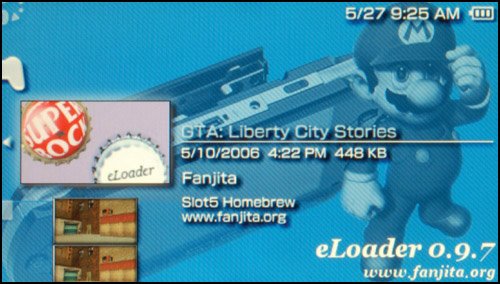PSP Possibilities
| So you've bought this little gadget. What do you do with it? Happily, the answer is, lots of things! Honestly, though, I wouldn't recommend using it as a self-defense weapon against muggers, as stated earlier. But what you can do with it is vast and varied. It's not just a game platform. Your PSP is a full-fledged multimedia superthingie that lets you take all kinds of media files on the road with you and enjoy them on trains, plains, and buses, in hotels, living rooms, farms, backyards, schools, and cars (as long as you're not driving). No matter where you go, there's something to do with your PSP. Just look at the possibilities. GamingIf you're like me, gaming is a very big part of your life, if it's not entirely your life, which it really could be. Healthy or not, games mean more to some people than trivial junk like ... oh, say, family, friends, money, and the like. The PSP was designed to be a truly high-performance gaming powerhouse, complete with graphics that rival those of the legendary PlayStation 2, audio that sounds more realistic than the dog barking next door, and controls that are incredibly innovative for a portable gaming system. When you pop in a UMD and fire up Grand Theft Auto: Liberty City Stories (Figure 1.1) or SOCOM: U.S. Navy SEALs Fireteam Bravo, you're in for an experience. If you're used to an earlier breed of portable game systemperhaps one that rhymes with lame toythe graphics served up by your PSP will cause your jaw to fall right off and land in your lap. Figure 1.1. Grand Theft Auto: Liberty City Stories is a popular game for the PSP.
This is real 3D: fully polygonal objects in a world with virtual depth. You're not limited to scrolling back and forth, left and right, until you grow weary with crushing boredom. These graphics are the ones that PC and modern console players are familiar with already, but on a system that goes where you do. The buttons on the right are labeled just like those on the PlayStation 2 controller, with a little circle, square, triangle, and X. The left side holds both a four-direction D-pad and an ingenious little analog thumb "stick." Look around, and you'll find systems with innovative gimmicks for game control, but you won't find one as comfortably familiar to any seasoned gamer as those that appear on the PSP. You aren't limited to single-player gaming, either. Through the use of wireless networking, you can play against other PSP owners and school them in front of their buddies. The PSP supports both ad-hoc and infrastructure Wi-Fi modes (don't worry if that phrase means nothing to you; I'll explain later) so you can play anywhere two PSP units can sense each other. The PSP is a bonanza of a gaming device, with scores of games already available for it and dozens more in development. Many titles are PSP exclusives that you won't find available for any other system, set-top or portable. Gamers, this one's for you. MoviesGaming is great, but sometimes, you'll find yourself in the mood for passive entertainment, the kind that you just sit back and watch while parts of your brain slowly turn to mush. There's nothing like watching a movie on a plane, but the movies shown on planes usually suck, and you have to pay extra for the headphones that may have someone else's ear fungus on them. Why bother? Bring along your PSP and the UMD movie of your choice, or some video you flung from your computer's hard drive onto a Memory Stick Duo (the removable memory card used by the PSP and many other devices). Snap in some headphones or crank up the volume loud enough to annoy your neighbor, and start watching Napoleon Dynamite, SpongeBob SquarePants, or whatever you're into (Figure 1.2). Figure 1.2. Watch what you want where you want, such as Napoleon Dynamite.
The PSP's bodacious screen, in a 16:9 widescreen aspect ratio just like a widescreen television set, does a fantastic job of displaying films. It comes with a range of controls so you can skip to your favorite scenes, loop sequences, pause, reverse, and so on. MusicThese days, it's almost a status symbol among the young hipsters who listen to Eels and Arcade Fire to own some sort of portable music device. They prance about with their earbuds in place, trailing white headphone cables to the little gadgets clipped to their belts, on their way to the local café, where they'll hang out with their friends and actively hate stuff. You, however, are far cooler than they would be even if they could play blues guitarwhich they can't, because they don't have the gumption to practice on the six-string Fenders they got a few Christmases ago from their parents, whom they wish would leave them alone. With the awesome power of your PSP, you can take music with you, too. Plus when you grow bored of listening to tunes, you can press a few buttons and start playing games or surfing the Web. Let's see those hipsters do that with their stylish little MP3 players! The PSP lets you dump music from your computer's hard drive onto Memory Stick Duos, load 'em up, and then play tunes wherever you go (Figure 1.3). You can create playlists; shuffle songs; and use any head-set you like, whether it's trendy white or traditional black. Figure 1.3. Queue up some tunes on your PSP. Who needs an MP3 player?
The PSP's audio processing is first rate, with clear-as-a-pin-drop sound and incredible fidelity. It sounds as good as any dedicated music device and even has a built-in equalizer for tweaking out the best tones for your tunes. ImagesIf you're a grownup, you probably have a wallet full of photographs of nephews, nieces, or even sons and daughters. If not, you still probably carry around pictures of friends, relatives, and the girl whom you claim is your girlfriend from Mexico. In the days of digital imaging, however, you also probably have hundredsif not thousands, if not even morepictures on a hard drive somewhere. With the limitations of film eliminated from the photographic equation, you can snap as many pictures as you like with your digital camera and never have to go to the one-hour-photo place and smell the embalming fluid (or whatever that stuff is that they use to process pictures). There's no longer a point to carrying around photo hard copies in the form of atoms when you can carry many, many more pictures in the form of bits on a PSP. Want to show off your baby's first teeth? Want to flash around your daughter in her ballerina outfit? Want to flaunt that awesome shot you snapped of your cat nabbing a mole? Want to embarrass your friend by publicizing the picture you caught right when he was doing a faceplant off his board? Load up those photos and more on a Memory Stick Duo, and take them all over creation on your PSP (Figure 1.4). Its bright and incredibly sharp screen will make you proud of the way your images look. You can even use a photograph as your PSP's wallpaper or force your acquaintances to sit through a slide show of all your favorite shots. Figure 1.4. Don't load up your wallet with pictures; flash them around on your PSP!
The World Wide WebYour PSP is equipped with what the manual calls WLAN technology, which some of us in the know call by its trade name, Wi-Fi. That heady term stands for wireless fidelity, which means easy networking without unattractive and inconvenient wires. If your house has a Wi-Fi network connecting multiple computers and/or game consoles to the Internet, you can use your PSP's built-in browser to surf the Web (Figure 1.5). You can also use it at hot spots, provided that you have an account with the provider (such as T-Mobile). Newer builds of the PSP firmware even contain an RSS client that lets you get feeds from various sources. Figure 1.5. With your PSP's built-in WLAN, you can hit the Web wherever there's a wireless network. Speaking of firmware, one of the other things you can do over a Wi-Fi Internet connection is update the PSP's firmware (or software, as the manual refers to it). That can open new capabilities for the unit and make it compatible with newer games. If you know someone who owns a PSP, you can play some games together via a Wi-Fi wireless link. SOCOM: U.S. Navy SEALs Fireteam Bravo and Twisted Metal: Head-On let you play the same game at the same time, competitively or cooperatively, provided that each of you has a copy of it. The only thing you can't do with the PSP's Wi-Fi capability is connect directly to a computer to transfer files. You need a USB cable for that, but don't worry; the cable is cheap, and the transfer is pretty easy to do. HomebrewJust when you think you've reached the limits of this remarkable device, get ready for the dark side of the PSP. Hacking and homebrew (Figure 1.6) are two terms you'll probably grow familiar with, as they mean that really clever and creative geeks have figured out how to do things with the PSP that Sony may never have considered. Figure 1.6. This "e-loader" uses Grand Theft Auto: Liberty City Stories to let you launch homebrew apps.
The term hacking has negative connotations. It makes people think of the nasty nerds who write computer viruses and make life difficult for fine, upstanding users who don't want their hard drives erased. That's not exactly what the word means, though: Hacking means doing things with technological equipment beyond the intentions of the manufacturers. Hacking a PSP, therefore, lets you do all kinds of fun stuff that Sony might not have intended but that the little device is capable of doing nonetheless. Homebrew means programs made at homein other words, little applications written by independent people who weren't licensed or approved by Sony. Popular homebrew applications let you do things like stream video to your PSP and play Macromedia Flash animations. Some homebrew "applications" are games! If you're dying for a free (and legal) Sudoku game to play on your PSP, learn the wonders of running homebrew. |
EAN: 2147483647
Pages: 95
- Assessing Business-IT Alignment Maturity
- Linking the IT Balanced Scorecard to the Business Objectives at a Major Canadian Financial Group
- A View on Knowledge Management: Utilizing a Balanced Scorecard Methodology for Analyzing Knowledge Metrics
- Measuring ROI in E-Commerce Applications: Analysis to Action
- Managing IT Functions




